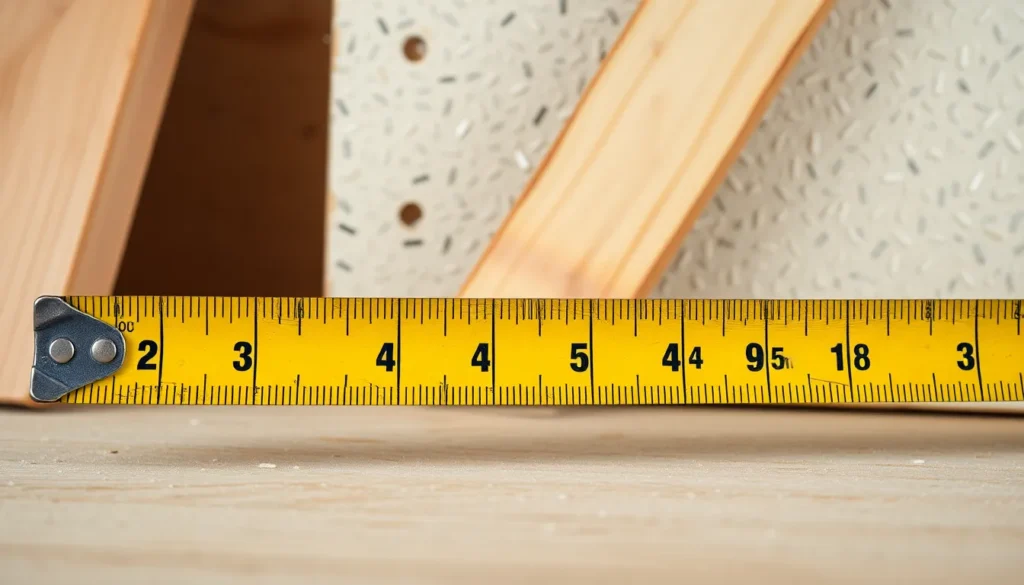When it comes to measurements, converting from inches to millimeters can feel like deciphering ancient hieroglyphics. But fear not! Understanding how 3/4″ translates into millimeters is simpler than finding the last cookie in the jar. Spoiler alert: it’s 19.05 mm.
Whether you’re a DIY enthusiast tackling a home project or a professional in need of precise specs, knowing this conversion can save the day. Imagine trying to fit a 3/4″ pipe into a millimeter-only world—chaos! So, buckle up as we dive into the world of inches and millimeters, making sure you’re equipped with the knowledge to impress your friends and avoid any measurement mishaps.
Table of Contents
ToggleUnderstanding Measurement Conversions
Conversions between measurements are essential in various applications. For instance, understanding how to convert 3/4″ to millimeters enhances precision in projects.
Importance of Accurate Measurements
Accurate measurements prevent costly mistakes in construction, crafting, and engineering. A single miscalculation can result in mismatched components, leading to project delays. Attention to detail fosters reliable results. Many professionals rely on precise dimensions to ensure quality and safety. DIY enthusiasts benefit from accurate conversions as it enhances their work and boosts confidence in projects. Thus, it becomes clear that measuring correctly plays a critical role in achieving desired outcomes.
Common Measurement Systems
Measurement systems like the imperial and metric serve distinct regions and standards. The imperial system, used primarily in the United States, expresses dimensions in inches, feet, and pounds. The metric system dominates in many countries, utilizing millimeters, centimeters, and kilograms. Each system maintains unique advantages; however, converting between them ensures universal understanding. Many tools allow for easy conversions, making it simple to switch between systems as needed. Understanding both measurement systems fosters clear communication in various fields and disciplines.
Converting 3/4″ to mm
Converting 3/4″ to millimeters is straightforward and crucial for accurate measurements in various projects. The conversion ensures clarity in communication across different systems.
Step-by-Step Conversion Process
Start by recognizing that 1 inch equals 25.4 mm. Next, multiply 3/4 by 25.4. This calculation reveals that 3/4″ translates to 19.05 mm. Finally, confirming this value through different methods enhances reliability. Many tools simplify this process, providing instant results for convenience.
Conversion Formula Explained
The formula used for conversion remains consistent: mm = inches × 25.4. This formula effectively highlights the relationship between inches and millimeters. When applying this formula, one can easily convert any inch measurement to millimeters, reinforcing understanding of both systems. Values such as 1/2″, 1″, or 2″ can similarly be converted using this formula for accurate dimensions.
Practical Applications of 3/4″ in mm
3/4″ translates to 19.05 mm and has numerous practical applications in various fields. Understanding these applications helps ensure accuracy and efficiency in different projects.
Usage in Construction
Accurate measurements are critical in construction, especially when using materials that conform to both imperial and metric systems. Since 3/4″ equates to 19.05 mm, this measurement frequently appears in framing and drywall installations. Builders often rely on this precision to ensure structural integrity. Dimensions for frameworks, such as studs and joists, often incorporate measurements like 3/4″ to create robust buildings. Wrong conversions can result in material mismatches, increasing costs and causing delays. Familiarity with 19.05 mm allows construction professionals to communicate parameters effectively across diverse teams and regions.
Usage in Manufacturing
In manufacturing, precision drives productivity and quality. Equipment often requires components sized in both inches and millimeters. Commonly, parts like fasteners or fittings may specify a size of 3/4″, corresponding to 19.05 mm. Manufacturers use numerical accuracy to guarantee parts fit properly within larger assemblies. Machine operators benefit from knowing that 3/4″ aligns with key specifications across equipment and materials. Miscalculation in these realms can lead to production errors or machine failure. Consequently, understanding the conversion of measurements fosters a more streamlined manufacturing process.
Tools for Measurement Conversion
Various tools exist to simplify the conversion from inches to millimeters. These resources help professionals and DIY enthusiasts ensure accuracy during projects.
Conversion Charts
Conversion charts provide a quick reference for various inch and millimeter values. They show standard measurements such as 1/4″, 1/2″, and 3/4″, linking them directly to their millimeter equivalents. For instance, while 3/4″ equals 19.05 mm, charts display other common sizes, allowing users to find all relevant conversions without complex calculations. These charts typically cover a range from small fractions to whole inches, making them versatile for diverse applications.
Online Calculators
Online calculators also assist in converting measurements effortlessly. These digital tools allow users to input any inch value, instantly generating its millimeter equivalent. Many calculators feature user-friendly interfaces, providing results in real time. Moreover, these resources eliminate the potential for human error encountered with manual calculations. Reputable websites often include additional conversion features, such as reverse calculations from millimeters back to inches, enhancing their usefulness for various projects.
Mastering the conversion of 3/4″ to 19.05 mm is a vital skill for anyone working with measurements. With the right tools and knowledge, individuals can navigate the complexities of both the imperial and metric systems. This understanding not only enhances the accuracy of projects but also prevents costly mistakes that can arise from measurement errors.
As professionals and DIY enthusiasts continue to rely on precise dimensions, the ability to convert measurements confidently becomes increasingly important. Utilizing conversion charts and online calculators streamlines the process, ensuring that projects run smoothly and efficiently. Embracing this knowledge empowers individuals to achieve high-quality results in their work.









